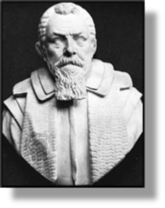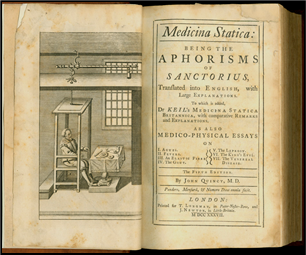


xxxxxThe Italian Santorio was the first physician to use precision instruments. He developed a pulse clock in 1602, and an elementary clinical thermometer in 1612. His book On Medical Measurement, published two years later, was a study of basal metabolism -
SANTORIO SANTORIO 1561 -
Acknowledgements
Santorio: marble bust at the entrance to his mausoleum, sculptor unknown – Church of the Servi, Venice. Weighing Chair: frontispiece to the 1737 edition of his On Medical Measurement, first published in 1614, artist unknown.
 xxxxxThe inventive Italian physician Santorio Santorio graduated from the University of Padua in 1582, and returned to be professor of medical theory from 1611 to 1624. His last years were spent in retirement in Venice. He regularly corresponded with the Italian anatomist Hieronymus Fabricius and the Italian astronomer Galileo, and he gained a reputation for his medical inventions. He was, in fact, the first physician to use precision instruments in medical practice. For this purpose he developed a pulse clock in 1602, and made the first attempt at producing a clinical thermometer in 1612.
xxxxxThe inventive Italian physician Santorio Santorio graduated from the University of Padua in 1582, and returned to be professor of medical theory from 1611 to 1624. His last years were spent in retirement in Venice. He regularly corresponded with the Italian anatomist Hieronymus Fabricius and the Italian astronomer Galileo, and he gained a reputation for his medical inventions. He was, in fact, the first physician to use precision instruments in medical practice. For this purpose he developed a pulse clock in 1602, and made the first attempt at producing a clinical thermometer in 1612.
 xxxxxHe also made some inroads into basal metabolism (the general activity of an individual's body). In an attempt to test out the theory put forward by the Greco-
xxxxxHe also made some inroads into basal metabolism (the general activity of an individual's body). In an attempt to test out the theory put forward by the Greco-
J1-


